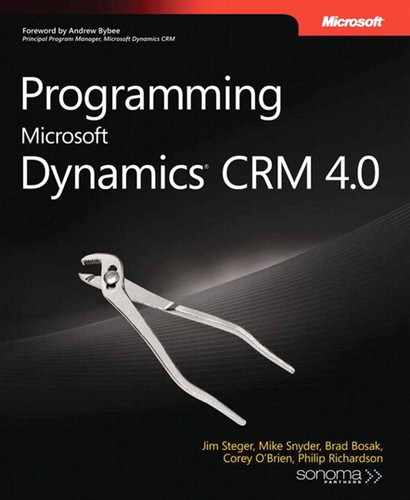In addition to the topics discussed in depth within this chapter, please keep the following items in mind as you prepare your environments.
Thoroughly review the Implementation Guide for installation and configuration details about Microsoft Dynamics CRM deployment and environment options.
Understand the business requirements for your Microsoft Dynamics CRM project and how they affect development and testing. You should have an environment for each configuration you plan to support that mirrors production.
Create both a development and a staging environment. You can make use of virtualization to help mitigate hardware costs.
Use a source control system (for example, Visual SourceSafe or Subversion) for your custom files and consider a continuous integration tool (such as CruiseControl.NET) as well.
Back up your databases and any custom source files. You can use the Microsoft Dynamics CRM API to easily export your customizations and include that in your backup procedures.
Multi-tenant deployments require Microsoft Dynamics CRM 4.0 Enterprise Edition.
You can add and delete organizations only through the Deployment Manager installed on the Microsoft Dynamics CRM Web server.
Microsoft Dynamics CRM 4.0 stores all of its transactional data and metadata in one database called <organization>_mscrm, where <organization> is the name of the organization you configured when you deployed. In addition to this database, Microsoft Dynamics CRM uses one configuration database (mscrm_config), which manages the different organizations and their settings installed on that SQL Server instance.
Microsoft Dynamics CRM 4.0 allows only one installation per SQL Server instance. You need to install another brand-new Microsoft Dynamics CRM environment to another SQL Server instance or a completely separate SQL Server instance.
You can share SQL Server, Reporting Services, and Exchange Server hardware between your staging and development environments, provided that you use multi-tenancy.
You can use virtual servers to create complete instances of Microsoft Dynamics CRM or any of the components. Monitor performance and determine whether you need to apply more resources to the virtual image or possibly move to a physical server.
Remember that each organization is an isolated environment of customizations and data. You cannot natively share data or records between organizations, although you can write tools (or find third-party tools) to synchronize the data.
Create organizational units (OUs) in your development Active Directory domain for each separate installation so that it is easier to keep track of your installation groups in Active Directory.
Use the new import organization feature of the Deployment tool to synchronize your data between Microsoft Dynamics CRM deployments in different domains. You cannot simply restore the databases to the new domain because the system GUIDs will not match.
